
A battery-powered, boiler-tube beveling tool that delivers the same power as a pneumatic beveler but is truly cord-free, making it suitable for quick welding end preps is available from Esco Tool. The Tube Weasel Battery MILLHOG is a right-angle drive I.D. clamping welding end prep tool featuring an 850 Watt motor with a proprietary gear reduction system that delivers high torque at 43 rpm. Capable of pulling a thick chip without cutting oils on tubes prone to work hardening at high speeds, this battery powered end prep tool is ideal for quick repair jobs.
Suited for beveling SS tubes with a high chrome content and high nickel percentage tubes, the Tube Weasel Battery MILLHOG is equipped with a 6.2 Ah 18 V rechargeable lithium-ion battery and employs TiN-coated cutter blades mounted in a wedge-style blade lock system. Designed for tubes from 3/4" I.D. to 3” O.D., it only requires a 3” radial clearance.
Contact Details
Related Glossary Terms
- clearance
clearance
Space provided behind a tool’s land or relief to prevent rubbing and subsequent premature deterioration of the tool. See land; relief.
- hardening
hardening
Process of increasing the surface hardness of a part. It is accomplished by heating a piece of steel to a temperature within or above its critical range and then cooling (or quenching) it rapidly. In any heat-treatment operation, the rate of heating is important. Heat flows from the exterior to the interior of steel at a definite rate. If the steel is heated too quickly, the outside becomes hotter than the inside and the desired uniform structure cannot be obtained. If a piece is irregular in shape, a slow heating rate is essential to prevent warping and cracking. The heavier the section, the longer the heating time must be to achieve uniform results. Even after the correct temperature has been reached, the piece should be held at the temperature for a sufficient period of time to permit its thickest section to attain a uniform temperature. See workhardening.
